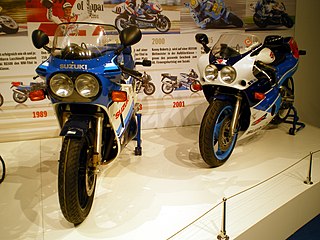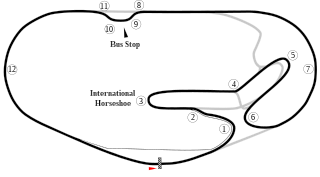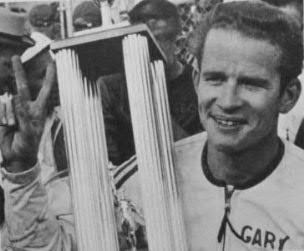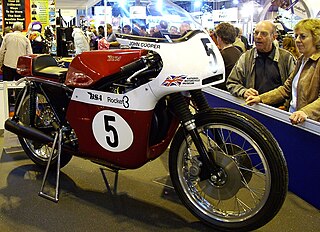
Suzuki GSX-R is a series of sports motorcycles made by Japanese automotive manufacturer Suzuki since 1984.

AMA Superbike Championship is an American motorcycle racing series that has been run every year beginning in 1976. For most of its existence it has been considered the premier motorcycle road racing series in the United States. It is sanctioned by the AMA American Motorcyclist Association since its inception, and the promotion of the series has been licensed to several organizations over the years. Since 2015 the series has been run and promoted by MotoAmerica, who also manage several other AMA professional road racing championships, including the popular 600cc Supersport class.

The Daytona 200 is an annual motorcycle road racing competition held in early spring at the Daytona International Speedway in Daytona Beach, Florida. The 200-mile (320 km) race was founded in 1937 when it was sanctioned by the American Motorcyclist Association (AMA). The original course used the beach itself before moving to a paved closed circuit in 1961. The Daytona 200 reached its zenith of worldwide popularity in the 1970s when the race attracted the largest crowds of any AMA race along with some of the top rated international motorcycle racers.

Pat Hennen is an American former Grand Prix motorcycle road racer. He is notable for being the first American to win a 500 cc World Championship race, the 1976 500cc Finnish Grand Prix. Competing as a non-factory rider, he finished third overall in the GP World Championship standings that season, only 2 points behind runner-up Tepi Länsivuori and fellow Suzuki factory rider Barry Sheene.
Miguel Duhamel is a Canadian former professional motorcycle racer. He is the son of Canadian Motorsport Hall of Fame member Yvon Duhamel. He is tied with Toni Elias for the fourth-winningest rider in the AMA Superbike series with 32 wins. Duhamel was inducted into the AMA Motorcycle Hall of Fame in 2016.

Gary Nixon was an American professional motorcycle racer who most notably won the A.M.A. Grand National Championship in 1967 and 1968 as a member of the Triumph factory racing team. He was also the winner of the 1967 Daytona 200 motorcycle race on a 500cc Triumph Daytona.

The Kawasaki Z1 is a four-cylinder, air-cooled, double-overhead camshaft, carbureted, chain-drive motorcycle introduced in 1972 by Kawasaki. Following the introduction of Honda's CB750 in 1968, the Z1 helped popularize the in-line, across-the-frame four-cylinder, a format that became known as the Universal Japanese Motorcycle or UJM.
Eric Bostrom is an American professional motorcycle racer and brother of Ben Bostrom, who also races motorcycles professionally.
Yvon Duhamel was a French Canadian professional motorcycle and snowmobile racer. A six-time winner of the White Trophy, the highest award in Canadian motorcycle racing, he was one of the most accomplished motorcycle racers in Canadian motorsports history. His motorcycle racing career spanned the transition from the 60 horsepower four-stroke motorcycles of the 1960s, to the 100 horsepower two-stroke motorcycles of the 1970s. Duhamel was a versatile rider competing in numerous motorcycle racing disciplines including; trials, motocross, ice racing, drag racing, flat track racing and most prominently in road racing as a member of the Kawasaki factory racing team.

Paul Smart was an English short circuit motorcycle road racer who later entered Grands Prix.
Rob Muzzy is an American owner of Muzzy's Performance Products, a specialty engineering company that designs, manufactures and sells high performance parts for motorcycles. He is also a successful motorcycle racing team owner, winning national and international championships in motorcycle road racing and drag racing. His contributions to motorcycle racing resulted in his induction into the AMA Motorcycle Hall of Fame.
The Kawasaki KR750 was a racing motorcycle built by Kawasaki. It featured a liquid-cooled, three-cylinder, two-stroke engine. In 1975, the first version was approved by the AMA and in 1976 it was improved by fitting new brakes and forks. The update of this bike was introduced in 1977.

Elena Myers Court is an American professional motorcycle racer. She made history in 2010 as the first female to win an AMA Pro Racing sprint road race. She is also the first woman to win a professional motorsports race of any kind at Daytona International Speedway, on March 17, 2012.

Eskil Suter is a former Grand Prix motorcycle road racer and current motorcycle chassis constructor from Switzerland.

MotoAmerica is the organization that promotes the AMA Superbike Series since 2015. Sanctioned by the American Motorcyclist Association (AMA) and the Fédération Internationale de Motocyclisme (FIM), it features six classes of road racing: Superbike, Stock 1000, Supersport, Twins Cup, Junior Cup, and Mini Cup.

The Transatlantic Trophy was an annual series of motorcycle races between the United Kingdom and America held from 1971 to 1988 and again in 1991. They were mostly held over the Easter weekend at Brands Hatch, Mallory Park and Oulton Park, although some races were held at Donington Park and Snetterton. Three different specifications of motorcycles were used in the series at various times: AMA/F750, Superbike and GP.
Don Castro is an American former professional motorcycle racer who is an inductee of the AMA Motorcycle Hall of Fame. During his career he was a works rider for Triumph and Yamaha' and a privateer on Triumph, Montesa, Yamaha and Kawasaki machines.

The BSA/Triumph racing triples were three cylinder 750 cc racing motorcycles manufactured by BSA/Triumph and raced with factory support from 1969-1974. There were road racing, production racing, endurance racing and flat track variants. The machines were based on the road-going BSA Rocket 3/Triumph Trident.

The John Player Norton, also referred to as JPN and JPS Norton, were a series of Formula 750 racers manufactured by Norton Motorcycle Company from 1972 to 1974 and sponsored by cigarette manufacturer John Player. The engine for these machines was derived from the unit used in the Norton Commando, which was a development of the 1948 Bert Hopwood designed 500 cc Dominator. The lack of power from the engine, compared with other manufacturers, led designer and rider Peter Williams to a adopt a radical approach to chassis design. Riders of the bikes included Williams, Phil Read, Tony Rutter, Mick Grant, John Cooper, Dave Aldana and Dave Croxford.
The 2022 MotoAmerica Supersport Championship season was the 8th season of the MotoAmerica Supersport class. The defending class champion was Sean Dylan Kelly, who vacated his title during 2022 to race internationally in Moto2.











